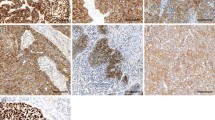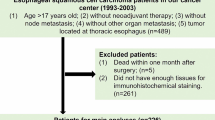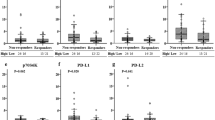Abstract
Background
While chemoradiation therapy (CRT) is one of the most useful treatments for esophageal squamous cell carcinoma (ESCC), it is important to predict response prior to treatment by using markers because some patients respond well and others do not.
Methods
Fifty-nine patients with ESCC were treated with neoadjuvant CRT at the Kagoshima University Hospital. The expression of seven types of biomarker candidate proteins in biopsy specimens of untreated primary tumors was evaluated to determine whether it correlated with response and prognosis.
Results
The positive expression rates were 47% for p53, 83% for CDC25B, 68% for 14-3-3sigma, 76% for p53R2, 75% for ERCC1, 32% for Gli-1, and 54% for Nrf2. In terms of histological response, tumor grade of the 59 patients was 48.8% for grade 1 as the non-responder, 29.2% for grade 2, and 22.0% for grade 3 as the responder. CRT was significantly effective in p53(−), p53R2(−), ERCC1(−), and Nrf2(−) tumors, while p53(−), p53R2(−), and ERCC1(−) were factors independently correlated with effective histological response. Their combined expression of two or three negative expressions had 100% effective response and was a significant prognostic factor.
Conclusion
Our results suggest that two or three negative expressions of p53, p53R2, and ERCC1 in biopsy specimens of primary tumors were associated with a favorable response to CRT for ESCC. Assessment of tumor suppressor and DNA repair protein expressions in biopsy specimens may be useful for the potential utility of CRT therapy for patients with ESCC prior to treatment.


Similar content being viewed by others
References
Tachimori Y, Ozawa S, Numasaki H, et al. Comprehensive registry of esophageal cancer in Japan, 2009. Esophagus. 2016;13:110–37.
Natsugoe S, Matsumoto M, Okumura H, et al. Clinical course and outcome after esophagectomy with three-field lymphadenectomy in esophageal cancer. Langenbecks Arch Surg. 2010;395:341–46.
Tachimori Y, Ozawa S, Numasaki H, et al. Efficacy of lymph node dissection by node zones according to tumor location for esophageal squamous cell carcinoma. Esophagus. 2016;13:1–7.
Natsugoe S, Ikeda M, Baba M, et al. Long-term survivors of advanced esophageal cancer without surgical treatment: a multicenter questionnaire survey in Kyushu, Japan. Dis Esophagus. 2003;16:239–42.
Okumura H, Uchikado Y, Matsumoto M, et al. Prognostic factors in esophageal squamous cell carcinoma patients treated with neoadjuvant chemoradiation therapy. Int J Clin Oncol. 2013;8:329–34.
Okumura H, Uchikado Y, Omoto I, et al. The usefulness of neoadjuvant chemoradiation therapy for locally advanced esophageal cancer with multiple lymph-node metastases. Ann Surg Oncol. 2014;21:2845–49.
Okumura H, Uchikado Y, Setoyama T, et al. Biomarkers for predicting the response of esophageal squamous cell carcinoma to neoadjuvant chemoradiation therapy. Surg Today. 2014;44:421–28.
Sobin LH, Wittekind C. International Union Against Cancer (UICC) TNM classification of malignant tumours, 6th edn. New York: Wiley; 2002.
Japan Esophageal Society. Japanese Classification of Esophageal Cancer, 4th edn, part I. Esophagus. 2009;6:1–25.
Japan Esophageal Society: Japanese Classification of Esophageal Cancer, 4th edn, parts II and III. Esophagus. 2009;6:71–94.
Okumura H, Natsugoe S, Yokomakura N, et al. Expression of p53R2 is related to prognosis in patients with esophageal squamous cell carcinoma. Clin Cancer Res. 2006;12:3740–45.
Miyata H, Doki Y, Shiozaki H, et al. CDC25B and p53 are independently implicated in radiation sensitivity for human esophageal cancers. Clin Cancer Res. 2000;6:4859–65.
Okumura H, Kita Y, Yokomakura N, et al. Nuclear expression of 14-3-3 sigma is related to prognosis in patients with esophageal squamous cell carcinoma. Anticancer Res. 2010;30:5175–79.
Kim MK, Cho KJ, Kwon GY, et al. ERCC1 predicting chemoradiation resistance and poor outcome in oesophageal cancer. Eur J Cancer. 2008;44:54–60.
Yoshikawa R, Nakano Y, Tao L, et al. Hedgehog signal activation in oesophageal cancer patients undergoing neoadjuvant chemoradiotherapy. Br J Cancer. 2008;98:1670–74.
Kawasaki Y, Okumura H, Uchikado Y, et al. Nrf2 is useful for predicting the effect of chemoradiation therapy on esophageal squamous cell carcinoma. Ann Surg Oncol. 2014;21:2347–52.
Lowe SW, Bodis S, McClatchey A, et al. p53 status and the efficacy of cancer therapy in vivo. Science. 1994;266: 807–10.
Caelles C, Helmberg A, Karin M. p53-dependent apoptosis in the absence of transcriptional activation of p53-target genes. Nature. 1994;370:220–23.
Wagata T, Shibagaki I, Imamura M, et al. Loss of 17p, mutation of the p53 gene, and overexpression of p53 protein in esophageal squamous cell carcinomas. Cancer Res. 1993;53:846–50.
Tanaka H, Arakawa H, Yamaguchi T, et al. A ribonucleotide reductase gene involved in a p53-dependent cell-cycle checkpoint for DNA damage. Nature. 2000;404:42–49.
Yamaguchi T, Matsuda K, Sagiya Y, et al. p53R2-dependent pathway for DNA synthesis in a p53-regulated cell cycle checkpoint. Cancer Res. 2001;61: 8256–62.
Okumura H, Natsugoe S, Matsumoto M, et al. The predictive value of p53, p53R2, and p21 for the effect of chemoradiation therapy on oesophageal squamous cell carcinoma. Br J Cancer. 2005;92:284–89.
Kwon HC, Roh M, Oh SY, et al. Prognostic value of expression of ERCC1, thymidylate synthase, and glutathione S-transferase P1for 5-fluorouracil/oxaliplatin chemotherapy in advanced gastric cancer. Ann Oncol. 2007;18:504–09.
Joshi MB, Shirota Y, Danenberg KD, et al. High gene expression of TS1, GSTP1, and ERCC1are risk factors for survival in patients treated with trimodality therapy for esophageal cancer. Clin Cancer Res. 2005;11:2215–21.
Kim MK, Cho KJ, Kwon GY, et al. Patients with ERCC1-negative locally advanced esophageal cancers may benefit from preoperative chemoradiotherapy. Clin Cancer Res. 2008;14:4225–23.
Acknowledgements
This study was supported by a Grant-in-Aid for Scientists from the Ministry of Education, Culture, Sports, Science and Technology of Japan to Hiroshi Okumura (Grant Number 15K10107).
Disclosures
Masahiro Noda, Hiroshi Okumura, Yasuto Uchikado, Itaru Omoto, Ken Sasaki, Yoshiaki Kita, Shinichiro Mori, Tetsuhiro Owaki, Takaaki Arigami, Yoshikazu Uenosono, Akihiro Nakajo, Yuko Kijima, Sumiya Ishigami, Kosei Maemura, and Shoji Natsugoe have no financial disclosures to declare.
Author information
Authors and Affiliations
Corresponding author
Electronic supplementary material
Below is the link to the electronic supplementary material.
Rights and permissions
About this article
Cite this article
Noda, M., Okumura, H., Uchikado, Y. et al. Correlation Between Biomarker Candidate Proteins with the Effect of Neoadjuvant Chemoradiation Therapy on Esophageal Squamous Cell Carcinoma. Ann Surg Oncol 25, 449–455 (2018). https://doi.org/10.1245/s10434-017-6271-y
Received:
Published:
Issue Date:
DOI: https://doi.org/10.1245/s10434-017-6271-y




